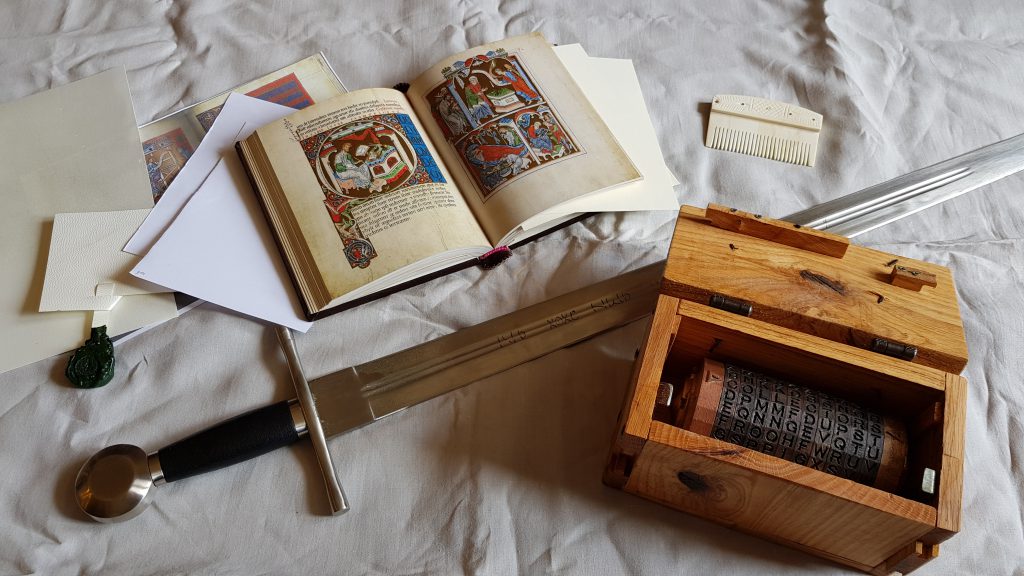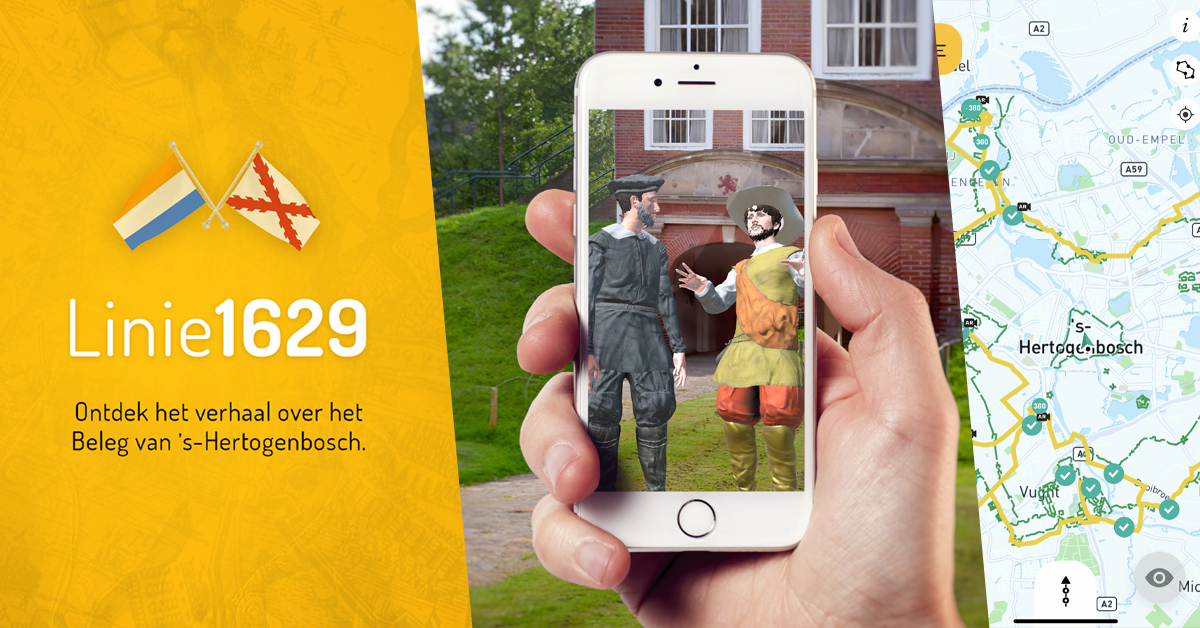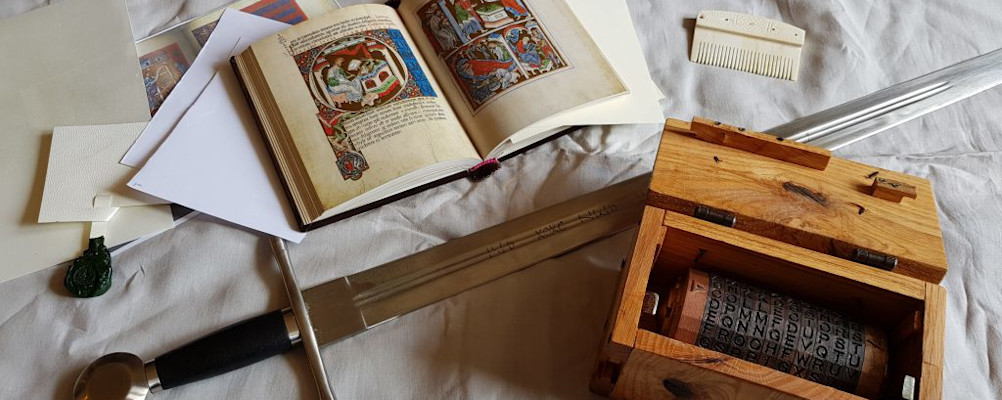Five immersive projects in the heritage sector
__The combination of heritage and immersive techniques is one of the newest cultural trends. The application of Virtual Reality (VR) or Augmented Reality (AR) offers opportunities for exhibition, experience, reconstruction and narrative forms. In the Fieldlab Virtual Worlds, an experiment coordinated by CLICKNL, we bring VR/AR makers and heritage institutions together. In collaboration with Media Perspectives, the Meertens Institute (KNAW) and the Dutch Institute for Sound and Vision. We share five examples of immersive projects in the heritage sector in this article which have come about thanks to the Fieldlab. __
1. TIME WINDOWS (MUSEUM OF ANCIENTS, ALLARD PIERSON MUSEUM, ARCHEOLOGICAL MUSEUM HAARLEM AND NOVITAS HERITAGE)
Time Windows is a collaboration project between multiple parties. Together with InCamera, YHEP! Media, Escape Lab, Intothemirror, Turf Real Life Gaming, Interweave and Made by van Eeden, Novitas Heritage has developed two experiences with support from the Fieldlab Virtual Worlds, the Province of South Holland (as a provider), Archeological Museum Haarlem and the Museum of ancients as partners and locations and the Allard Pierson Museum as a test location for Crossroads, the reason for the project.

Time Windows is a project that combines various disciplines such as the world of escape rooms/games, digital media and the heritage sector. It concerns two short "games" with physical and digital puzzles with an archaeological/historical theme. These pop-up games can be used in various museums and, for example, at events. Each game lasts about 15 minutes and asks the players to test futuristic technology (Time Windows/scanners). To do this, they must solve a historical case.
Players must discover what happened to the soldier Titus by using the first scanner. His belongings are hidden in several locked boxes. To reach solutions, players must solve both physical and AR puzzles. The background is the Roman past of the region, such as the Batavian Rebellion. The second scanner allows the players to read "dead" objects. The scanner provides digital information about the object so that the players must solve a mystery surrounding the Loonse War by uncovering the stories of those involved.
2. REMBRANDT PRIVATE (CITY ARCHIVE AMSTERDAM, SYNERGIQUE AND ORB AMSTERDAM)
The exhibition "Rembrandt Private" is the contribution of the Amsterdam City Archives to the commemoration of the 350th year of death of the greatest painter in Dutch history. The exhibition on Rembrandt's personal life was on display from 7 December 2018 to 7 April 2019 in the City Archives of Amsterdam.
With AR, the sources and knowledge about Rembrandt have been brought together in a new way. Due to language and handwriting, the documents containing stories about Rembrandt's personal life are difficult to read. These stories about love, money and art have been made accessible to a wide audience with AR. With an iPad, visitors can enrich the original documents with images and sound that bring these stories to life.
The AR experience was created by the designers of Synergique and ORB Amsterdam. The exhibition has been visited by almost 9.000 paying visitors. By getting two nominations, for a SpinAward and a European Design Award, the AR app was also highly appreciated in the professional world.
3. 100 YEARS OF WOMEN'S ELECTION - TOURIST VIEWER (ATRIA KNOWLEDGE INSTITUTE FOR EMANCIPATION AND HISTORY OF WOMEN, FOUNDATION OF PUBLIC LIBRARY AMSTERDAM, HIGH SCHOOL OF AMSTERDAM AND JUSTIN ZIJLSTRA).
In 2019, 100 years of active Women's Suffrage was celebrated as an important milestone. A VR experience has also been added to the "On the street" exhibition in Atria. In the experience, the visitor will be taken on a time journey to electoral demonstrations from the past. Also, the exhibition features posters, buttons, pins, important archive documents and paintings of key figures from the struggle for women's suffrage.
4. LINIE 1629 ROUTE APP (HERITAGE ’S-HERTOGENBOSCH, WIJDOENDINGEN AND SINT LUCAS)
Delpher is available since November 2013. This website has been developed by the Koninklijke Bibliotheek. Here you can find millions of digitised texts from Dutch newspapers. In the historiography about the siege of 's-Hertogenbosch, no use has yet been made of the newspapers that appeared during the siege in Amsterdam and Antwerp. It would be interesting to have comparative material for two courtiers (war reporters) to tell the story of friend and enemy. This is how the idea for the Linie 1629 Route App came about. Guides/courtiers Casper and Abraham take you along the Line.


In the app, you are taken by these two war reporters who both tell one side of the story. In this way, you always get the siege of the city in 1629 presented from two perspectives. You will also learn more about the applied war tactics, the role of religion, money and family ties in the siege. An interactive map with seventeen storytelling points spread across four municipalities is the result. Your smartphone indicates the route and distance to the storytelling sites. On arrival at the location, the user receives a notification in the app, after which the story of the location is told by the two courtiers, supplemented with historical facts and map material. Besides that, also 360-degree panoramas, sconces and fortifications are made visible again. The two courtiers also come to life in augmented reality. The app for cycle route Linie 1629 will be officially launched on 9 September.
5. CARNIVAL DE MOUTONS (EYE FILMMUSEUM AND DROPSTUFF.NL)
Carnival de Moutons is a project that has become part of art collective "De Koude Kermis". This is a series of artwork travelling through the Netherlands intended for everyone. DROPSTUFF.nl came in contact with Eye Filmmuseum thanks to Fieldlab Virtual Worlds. The merry-go-round "Carnival de Moutons" is an ode to the zoetrope. One of the first devices invented with which moving images were created, found by William George Horner in 1834. This artwork combines this oldest way of moving image with one of the newest techniques named AR.

Carnival de Moutons © DROPSTUFF.nl
The visitor can sit on one of the sheep in the merry-go-round. Then you look through a passe-partout at an XXL zoetrope strip, with more than 200 small images. This experience is enriched with a virtual layer through AR glasses. In this layer, you can also see more than twenty other digitised animations. The people that are sitting on the sheep in the merry-go-round with AR glasses on, really become part of the artwork. Experiencing this yourself is much more fun. Check here to see when Koude Kermis is at a place near you.


